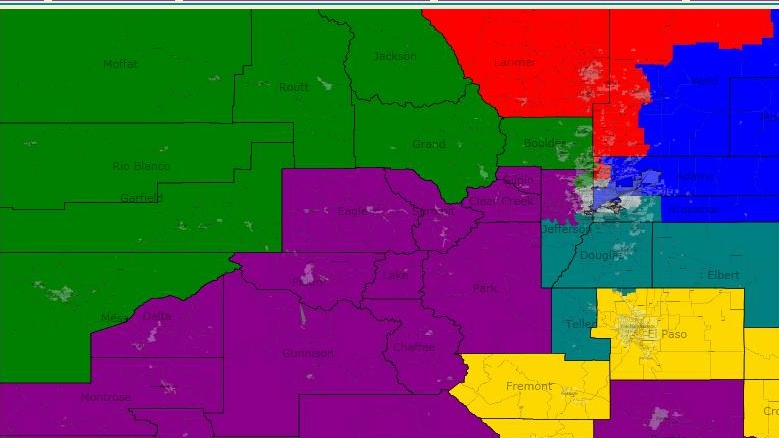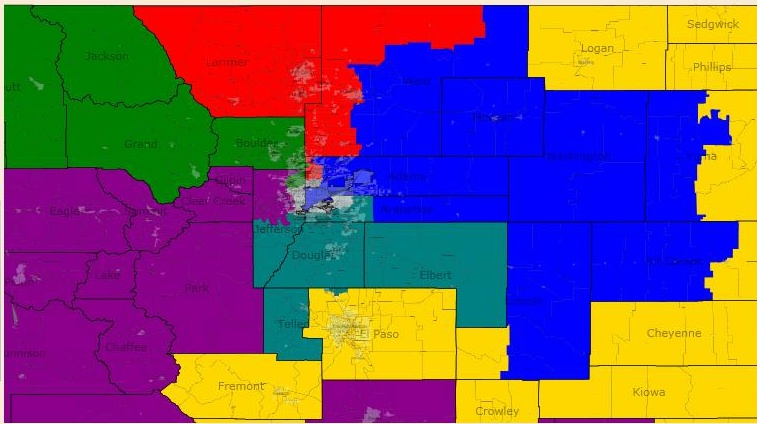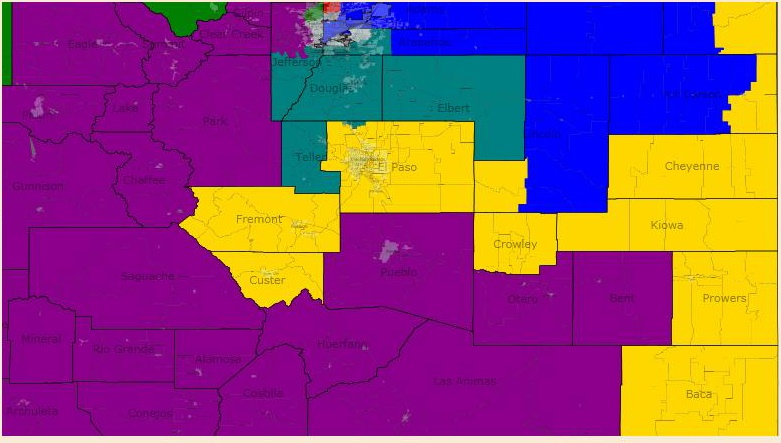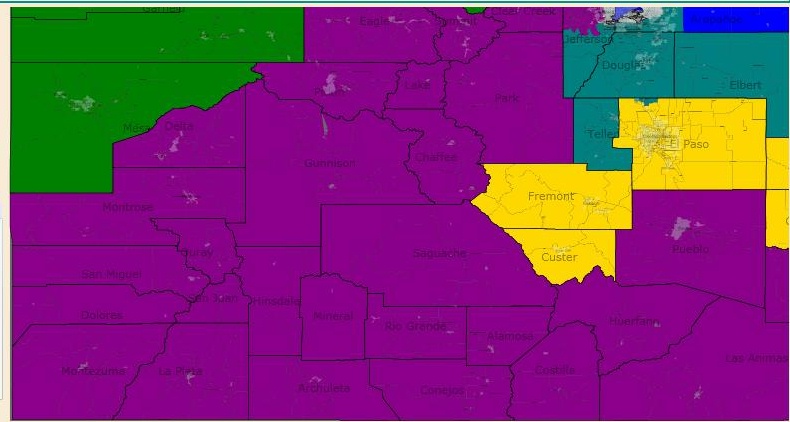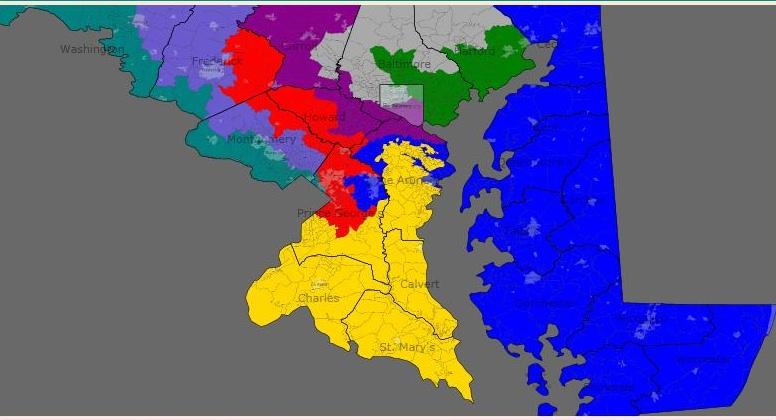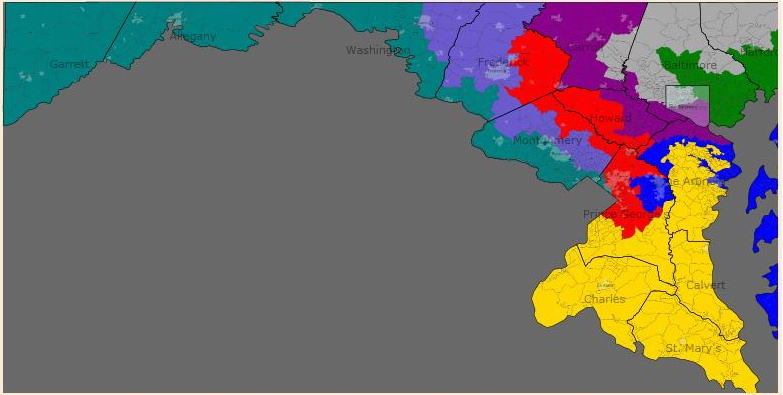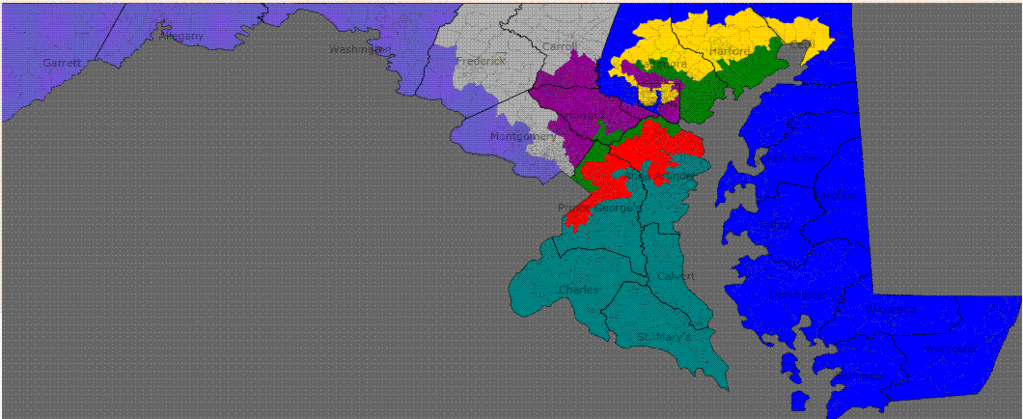Using Dave’s Application, I have drawn a redistricting plan for the Maryland legislature. The legislature is overwhelmingly Democratic (33 out of 47 Senators and 104 out of 141 Delegates), but because of population shifts since the last census, several Democratic seats may be at risk in the next round of redistricting.
Under the plan drawn in this diary, all Democratic seats are preserved and/or strengthened. Different things can happen in elections, but, in the most likely scenario, the new lines will add 3 or 4 Democratic Senators (Districts 9, 31, 37, and perhaps District 3 – if Alex Mooney survives the 2010 election) and between 11 and 14 Democratic Delegates (discussed later in the diary). (Yes, at that point the Democratic presence in the Maryland Legislature would approach that found today in the Massachusetts Legislature ! … well, maybe not quite that high, but in reality within 10 points of Massachusetts.) The new plan is also likely to add several African-American representatives, and possibly a new Hispanic member.
The new districts are also very compact and correspond to county lines and communities — even more so than the current map ! The links below are maps of the current districts to compare:
http://en.wikipedia.org/wiki/C…
http://en.wikipedia.org/wiki/L…
Under this proposed map, districts will cross county lines only when it’s necessary to preserve equal population and/or when necessary to preserve or strengthen minority-majority districts or minority-influenced districts. Even though Courts gave great leeway to the Governor in drawing Congressional seats last time, they were much more strict when it came to drawing state legislative seats. In effect, Gov. Glendening’s plan was ripped up and the Courts drew the existing plan.
The new plan I drew allows for population deviations of only 1,000 persons or less (much stricter than the existing map which I believe allowed for up to around plus/minus 5,000 persons). Most new districts are made where there’s one Senator and three Delegates; the only exceptions are more rural, multi-county districts as well as break-ups of districts into Delegate sub-districts in order to preserve or encourage minority-population representation.
Each district will contain approximately 120,000 persons. Sub-districts will contain 40,000 persons if designed for one Delegate, and 80,000 if designed for two Delegates. The only major instance of a district completely “re-locating” from one part of the state to another is District 46. Relative population decline/lack of growth in the city of Baltimore will necessitate the loss of one district there. No. 46 is the perfect candidate, as the other five districts are all minority-majority and have to be preserved under the VRA. The new District 46 will straddle the Baltimore Co./Harford Co. line (Harford Co. has been one of the fastest growing parts of the state) but has been designed to be a Democratic district.
MAPS:






DISCUSSION OF DISTRICTS:
District 1 – Western Maryland
New district: 93% white; 32% Obama (Obama percentage is same as in current district)
The only real change here is to divide into sub-districts a little differently from the current map:
1A – Garrett County, part of Allegany; 27% Obama (same as current district)
1B – Frostburg and Cumberland; 41% Obama (current district 34% Obama)
1C – parts of Allegany and Washington Counties; 31% Obama (current district 36% Obama)
I am really not sure why the sub-districts are currently drawn as they are. This re-drawing should shore up the one Democratic representative in this whole district, Kevin Kelly of 1B; his redrawn district will now include most of Cumberland. It is interesting to note that 1B is one of only two districts/sub-districts in the state where John Kerry performed better than Obama (the other is District 6).
District 2 – Washington County
New district: 82% white; 11% black; 45% Obama (Obama percentage is same as in current district)
No major changes here except to reconfigure the sub-districts. Instead of three sub-districts, the new plan has only two:
2A – Hagerstown and surrounding precincts; two Delegates; 49% Obama
2B – more rural remainder of District 2; one Delegate; 36% Obama
OK … this may be a slightly risky move (actually, the only really risky thing I do in this entire re-map). 2A will now combine the more Democratic Hagerstown with the more Republican precincts that immediately surround it. The wager is that two Democrats can be elected in a 49% Obama district; the risk is that two Republicans can as well, causing the loss of one Democratic Delegate. Perhaps the current plan can be basically preserved instead — where the sub-district corresponding almost exactly to the City of Hagerstown (55% Obama) is designed to elect the one Democrat, while the other two sub-districts continue to elect the GOP ?
Bottom line for District 2: Possible addition of one Democratic Delegate.
District 3 – City of Frederick and southern Frederick County
New district: 70% white; 13% black; 56% Obama (current district 54% Obama)
The major change here is to get rid of the sub-districts. A district that is 56% Obama (and becoming more Democratic as time goes on as more people from outside Frederick Co. stream in) should be able to elect three Democratic Delegates, instead of the current two in 3A (City of Frederick) and the Republican-turned-Independent in 3B (southern Frederick Co.). Right-wing GOP Senator Alex Mooney should probably be on the way out in elections next year (he won in 2006 with only 51.9% of the vote, and this district has experienced an influx of less conservative people moving in since then); the increase in the Democratic percentage (from 54% to 56% Obama) should help also once the new lines are in place in 2012.
Bottom line for District 3: Probable addition of Democratic Senator (if the incumbent survives 2010) and one Democratic Delegate.
District 4 – Frederick County, parts of Washington and Carroll Counties
New district: 90% white; 38% Obama (current district 37% Obama)
The sub-districts are eliminated and the new District 4 will now be confined mostly to Frederick County (previously about one-third of the district was in Carroll Co.) The only areas outside the county (necessary to preserve equal population of each district) will be Smithsburg in Washington Co. and Mt. Airy which straddles the Carroll Co./Frederick Co. line. The GOP is expected to dominate here.
District 5 – Carroll County
New district: 92% white; 32% Obama (current district 33% Obama)
Like with District 4, the sub-districts are eliminated and the district will now be completely confined to Carroll County, instead of stretching out into northern Baltimore County. GOP stronghold.
District 6 – Dundalk, Sparrows Point, east Baltimore
New district: 72% white; 21% black; 54% Obama (current district 45% Obama)
This area is a traditional blue-collar Democratic stronghold that has shifted to the right over the decades (your quintessential Reagan Democrat country). The current District 6 is the only full district in the state of Maryland (out of 47) where John Kerry performed better than Obama. Democrats still win here locally, but in order to make the district safer for the future, the Democratic percentage is increased substantially. This is done in tandem with combining parts of east Baltimore City with the Baltimore County portion of the district.
It should be noted that the break-down here is almost exactly such that the Baltimore City portion could be made into a sub-district electing one Delegate, while the Baltimore Co. part could be a two-Delegate sub-district. However, such a move might be politically risky. The Baltimore Co. part voted only 42% Obama and could realistically elect two Republicans at some point in the future if made into a sub-district. The Baltimore City part is plurality African-American (47% black; 44% white) and voted 83% Obama, but it probably contains almost as many registered white Democrats as black Democrats due to historical factors, so an African-American Delegate would not by any means be assured. Therefore, two good reasons to keep the new District 6 without sub-districts.
District 7 – northern Baltimore County, part of Harford County
New district: 88% white; 35% Obama (current district 39% Obama)
The new district combines most current areas of the district in Baltimore and Harford Counties with territory in northern-most Baltimore Co. which was previously part of District 5. The district becomes even more Republican than the current form.
District 8 – Parkville, Carney, Overlea, Rosedale, White Marsh
New district: 72% white; 16% black; 52% Obama (current district 48% Obama)
The current district is represented by a Democratic Senator, two Democratic Delegates and one Republican Delegate. The Republican won by a smidge last time, and the increase in the Democratic percentage (48% Obama to 52% Obama) should help.
Bottom line for District 8: Probable addition of one Democratic Delegate.
District 9 – Howard County (Ellicott City, west Columbia)
New district: 65% white; 15% black; 13% Asian; 58% Obama (current district 43% Obama)
The new District 9 is another good example of how we can make a district more compact, yet more Democratic at the same time. The current district stretches across Howard and Carroll Counties and is quite Republican. The new district is confined entirely to Howard Co. and is a lot more Democratic. (It should be noted that the detachment of the western part of Columbia from District 12 does not hurt that district at all, as explained
later).
Bottom line for District 9: Probable addition of Democratic Senator and three Democratic Delegates.
District 10 – parts of Baltimore Co. (Milford Mill, Lochearn, Randallstown) and Carroll Co. (Sykesville, Eldersburg)
New district: 51% black; 41% white; 67% Obama (current district 87% Obama)
The new district stretches along the Liberty Road corridor from just outside the Baltimore City line into Carroll County. The district is assured of continuing to elect an all African-American Democratic delegation as approximately 70-75% of the Democratic primary vote here is black, and the district overall is about two-thirds Democratic.
District 11 – northwestern Baltimore County
New district: 59% white; 30% black; 65% Obama (current district 66% Obama)
Remains solidly Democratic. I have divided the new district into two sub-districts:
11A – two-Delegate district; Reisterstown, Owings Mills, Mays Chapel; 72% white; 15% black; 56% Obama
11B – one-Delegate district; parts of Randallstown and Pikesville; 58% black; 33% white; 84% Obama
The creation of sub-district 11B should add one African-American to the state’s delegation. In the meantime, because of the way the lines are drawn, one of the current three Delegates here could run in the new District 42 which now will include a substantial part of Pikesville. The 56% Obama percentage in 11A should not be a concern, as this is a safe Democratic district, particularly on the local level. (John Kerry actually did better than Obama in several precincts of the new 11A, so Obama’s 56% percentage is not some sort of Democratic “ceiling” for the area, as it would be in other districts.)
Bottom line for District 11: Probable addition of African-American Delegate.
District 12 – southwestern Baltimore County; eastern Howard County
New district: 63% white; 24% black; 59% Obama (current district 58% Obama)
The new district covers much of the same area as the current district. The major exception is that a part of Columbia (sub-district 12B) is taken out. However, a new sub-district 12B (also with one Delegate) is created. The new 12B encompasses most of Woodlawn and is majority black, and its creation is likely to add another African-American to the state’s delegation. Here’s more numbers:
12A – two-Delegates; Catonsville, Elkridge; 77% white; 10% black; 50% Obama (current 12A is also 50% Obama)
12B – one-Delegate; Woodlawn; 53% black; 35% white; 81% Obama
Bottom line for District 12: Probable addition of African-American Delegate.
District 13 – Howard County (east Columbia, Savage, North Laurel)
New district: 60% white; 20% black; 10% Asian; 63% Obama (current district 65% Obama)
This district stays very similar to the current configuration. District 13 was represented in the state Senate by a Republican, Sandy Schrader, prior to the 2006 election (even when the three Delegates were all Democrats). Schrader won in 2002 with 50.95% of the vote, but received only 43.8% in her re-election attempt in 2006. This district has definitely moved in the Democratic direction over the years, and the slight decline in Democratic performance here under the proposed lines (from 65% Obama to 63% Obama) will still leave this a safe Democratic seat.
Districts 14, 15, 16, 17, 18, 19, 20 and 39 – Montgomery County
We next move to Montgomery County, where the district lines change very, very little under my map. The all-Democratic delegation here (8 Senators and 24 Delegates) is something I am very proud of (I live in Silver Spring). I attempted to create sub-districts here which could be designed to elect minority representatives, but my efforts were futile, as the minority population is very diverse and scattered throughout the county. But no tears lost … Even under the current lines, Montgomery is likely to elect a very multi-ethnic delegation — in fact, it already does so, with black, Hispanic, and Asian (east Asian, south Asian, as well as Middle Eastern-origin) representatives … and several openly gay representatives also.
New District 14: Burtonsville, Olney, Brookeville, Laytonsville, Damascus
59% white; 20% black; 12% Asian; 65% Obama (Obama percentage is same as in current district)
New District 15: Potomac, Poolesville, Clarksburg
67% white; 14% Asian; 65% Obama (Obama percentage is same as in current district)
New District 16: Bethesda, Garrett Park
70% white; 11% Asian; 11% Hispanic; 73% Obama (current district 74% Obama)
New District 17: Rockville, Gaithersburg
48% white; 20% Hispanic; 16% Asian; 12% black (quite diverse !); 71% Obama (Obama percentage is same as in current district)
New District 18: Wheaton, Kensington, Chevy Chase
51% white; 19% Hispanic; 18% black; 76% Obama (Obama percentage is same as in current district)
New District 19: Aspen Hill, Leisure World, Derwood
49% white; 18% black; 16% Hispanic; 13% Asian (another very diverse district); 68% Obama (Obama percentage is same as in current district)
New District 20: Silver Spring, Takoma Park, White Oak
31% white; 31% black; 23% Hispanic; 12% Asian (by far, the most ethnically diverse district in Maryland); what’s not diverse is political preference: 85% Obama (Obama percentage is same as in current district); this district is where I live, btw !
It should be noted that under this map, District 20 extends into two precincts in Prince George’s County, in order to meet equal population standards; however, the new districts may be designed in such a way where all eight Montgomery County seats are confined exclusively to the county (I’m using a deviation of under 1,000 persons, while Courts in the past have used a considerably higher number; bottom line: those two PG Co. precincts may not need to be a part of District 20).
New District 39: Germantown, Montgomery Village, North Potomac
50% white; 18% Asian; 15% black; 12% Hispanic; 71% Obama (Obama percentage is same as in current district)
District 21 – northern Prince George’s County
New district: 47% white; 31% black; 10% Hispanic; 78% Obama (current district 75% Obama)
The new district is now completely contained within PG Co. I just didn’t think that it made sense to have a district stretch from College Park all the way to Odenton in Anne Arundel County (as does the current District 21). I also divided the new district into sub-districts in order to create a minority-opportunity seat centered on Laurel, which is relatively more African-American than other parts of District 21 (it should be noted, though, that the current district already elects a minority representative who lives in College Park, so perhaps a sub-district is unnecessary here ?). The new numbers are:
21A – two Delegates; College Park, University Park, Beltsville, part of Bowie; 54% white; 24% black; Obama 76%
21B – one Delegate; Laurel; 46% black, 33% white; 11% Hispanic; Obama 83%
District 22 – northern Prince George’s County
New district: 50% black; 25% Hispanic; 16% white; 85% Obama (Obama percentage is same as in current district)
The new district is quite similar to the existing one. Senator Paul Pinsky should have no trouble getting re-elected here. Once he retires, however, this district is likely to elect an African-American Senator. I have also divided this district into sub-districts. Currently, two of the three Delegates here are white, even though the current district’s ethnic composition is similar to the proposed district. Creating sub-districts here may screw up that dynamic; however, I do so anyways in order to create a Hispanic-opportunity sub-district (Hispanics seem to be vastly under-represented in the state legislature):
22A – two Delegates; Greenbelt, New Carrolton, Landover Hills; 57% black; 18% Hispanic; 16% white
22B – one Delegate; Hyattsville; Riverdale; 39% Hispanic; 38% black; 16% white; the new 22B is barely Hispanic plurality; however, the Hispanic population is still growing here, so this district may become an opportunity district for the population.
Bottom line for District 22: Possible addition of a Hispanic Delegate.
District 23 – parts of Prince George’s Co. (Largo/Kettering, Mitchelville, Bowie) and Anne Arundel Co. (Crofton, Gambrills, Fort Meade)
New district: 45% black; 44% white; 74% Obama (current district 81% Obama)
Since this re-map made District 21 confined to PG Co., the new District 23 has to play the opposite role and reach outside PG, into Anne Arundel County. I think this proposed map is more logical — it makes much more sense to have Bowie and Crofton in the same district than to have College Park and Odenton in the same district.
The new district becomes plurality black, and most registered Democrats here are black (as a good part of the white population in Anne Arundel is Republican). Nevertheless, the numbers are not overwhelming either way, and should not hurt the currently racially-diverse delegation. I decided to drop the sub-districts however, as they seem unnecessary under the circumstances, and could only hurt Democratic chances if, for instance, a part of the Anne Arundel Co. portion of the district was made into a sub-district.
Districts 24, 25, 26 – central and southern Prince George’s Co.
These three districts remain largely very similar to the current districts.
New District 24: Capitol Heights, Seat Pleasant, Suitland, Glenarden; 86% black; 98% Obama (Obama percentage is same as in current district)
New District 25: District Heights, Forestville, parts of Upper Marlboro; 78% black; 14% white; 95% Obama (current district 96% Obama)
New District 26: Oxon Hill, Temple Hills, Fort Washington; 80% black; 93% Obama (current district 94% Obama)
District 27 – Calvert County and southern Prince George’s Co.
New district: 67% white; 26% black; 57% Obama (current district 71% Obama)
The new district is more compact than the current District 27, now taking in all of Calvert County (Calvert has experienced some of the highest population growth in the state, and will now account for two-thirds of the new district). The rest of the new district will be a Prince George’s Co.-based minority-majority sub-district. Thus, the major change here is that sub-district 27A will now have one Delegate, instead of two, and 27B will have two instead of one.
Senate Leader Mike Miller should be quite happy with the new lines, as his seat becomes more Calvert-based (his home) and it is less likely that he will be challenged in the Democratic primary by an African-American in the future.
27A – one Delegate; southern Prince George’s County and several precincts in Calvert and Charles to preserve equal population; 52% black; 40% white; 81% Obama (Obama percentage is same as in current sub-district)
27B – two Delegates; all of Calvert Co. except for northern-most area around Dunkirk; 79% white; 14% black; 47% Obama (Obama percentage is same as in current sub-district)
Even though sub-district 27B remains at only 47% Obama, it should be noted that the current Delegate, Democrat Sue Kullen, won with 57% of the vote in 2006. Anthony O’Donnell (from southern Calvert, currently in sub-district 29C) could also run here, but even if he were to win, his gain here would be effectively offset by his disappearance from District 29.
District 28 – Charles County
New district: 50% white; 39% black; 64% Obama (current district 63% Obama)
The lines here change only insofar that several precincts in the eastern part of the county are taken out to preserve equal population. There’s a good chance that this district will become majority black over the next decade.
District 29 – St. Mary’s County, part of Charles Co.
New district: 75% white; 17% black; 45% Obama (current district 44% Obama)
The new district is more compact than the current one, and all of St. Mary’s County will now be in one district. The sub-districts are eliminated, and I’m hopefully optimistic that all three Delegates will be Democrats (currently both Delegates in 29A and 29B, which are areas almost entirely in St. Mary’s County, are Democrats elected with 65 and 64 percent of the vote; Republican Anthony O’Donnell won 29C — which straddles both St. Mary’s and Calvert Counties — with 60% but his sub-district becomes split in half between the new District 27 and the new District 29.)
District 30 – Annapolis and environs in Anne Arundel Co.
New district: 73% white; 16% black; 53% Obama (current district 52% Obama)
The lines here are tweaked just a bit in order to make the district more Democratic. The current district is represented by a Democratic Senator and two out of three Delegates are also Democrats. The lone Republican, Delegate Ron George, won by 53 votes last time (or one-tenth of a percentage point), and so the change from 52% Obama to 53% Obama may be helpful in the future — assuming George even makes it through 2010 under the current lines, which is less than assured.
Bottom line for District 30: Probable addition of one Democratic Delegate (if the sole Republican is not defeated by the time the new lines come into being).
District 31 – Glen Burnie, Brooklyn Park, Riviera Beach
New district: 75% white; 14% black; 48% Obama (current district 40% Obama)
The political composition of this Anne Arundel district changes significantly under this re-map. Parts of Glen Burnie currently in District 32 are added (except for the homes of several District 32 incumbents which remain in the 32nd) while most of hyper-Republican Pasadena is detached. (Under the new lines, most of Glen Burnie is now part of one district, instead of being split in half between Districts 31 and 32.) The result is a district that goes from 40% Obama to 48% Obama.
It is quite likely that all four Republican representatives will disappear under the new lines, and will be replaced by four Democrats. The GOP Senator here, Bob Jones University graduate Bryan Simonaire, won last time with only 50.8% of the vote, and he lives in Pasadena, now outside the district. The three GOP Delegates all won by relatively small margins also, and two of the three also live in Pasadena.
The one Delegate whose home remains in the new 31st is Don Dwyer, a rabidly right-wing homophobe who makes Simonaire appear like a moderate in comparison (Dwyer is so right-wing that he has effectively taken himself out of the Republican caucus, as they are apparently not conservative enough for him, though he remains a Republican.) Dwyer won re-election by 25 votes last time (even the current 58% McCain district had barely the stomach for him), and it’s far from assured that he will win in 2010. If for some reason he makes it next year, the new lines and district composition will pose a very formidable obstacle for him in 2014.
This area, btw, is traditionally quite Democratic, but parts contain many conservative Reagan Democrats. In that light, the 48% Obama of the proposed District 31 should not be seen as a Democratic ceiling for the district; in a number of precincts in the area, including ones in Brooklyn Park and Riviera Beach, John Kerry performed better than Obama. (Disclosure: I grew up in Brooklyn Park, and my mom still lives there, hence this long entry re. District 31 … that, and the fact that the odious Don Dwyer is still a representative there.)
(It should be noted that in drawing this district, I used new precinct lines for the map in the very southern end of this district, where it dips into a sliver of Severna Park — precincts no. 5-10 and 5-12 on Dave’s Application — which are now really four separate precincts, not just two. The lines the Application uses are based on precincts as they existed in 2002 but in this particular area it made more sense to use the new lines to include a new African-American majority precinct into District 31 and exclude a very GOP new precinct nearby. Incidentally, the current border between Congressional Districts 1 and 3 in that area makes use of the same new lines).
Bottom line for District 31: Probable addition of Democratic Senator and three Democratic Delegates.
District 32 – Linthicum, Severn, Odenton, Arbutus/Lansdowne
New district: 61% white; 25% black; 54% Obama (Obama percentage is same as in current district)
Like the current incarnation, the new district encompasses much of northwestern Anne Arundel County. The district also crosses over into a part of Baltimore County, in order to maintain equal population. The current all-Democratic delegation looks to be in good shape under the new lines.
District 33 – Pasadena/Lake Shore, Severna Park, Crownsville, Davidsonville
New district: 89% white; 37% Obama (current district 43% Obama)
The new District 33 combines the most Republican communities of Anne Arundel County into one district. Geographically, it pretty much resembles the current district with Pasadena added. The two current sub-districts are eliminated.
I thought about having three separate sub-districts here – 1.) Pasadena, 2.) Severna Park/Crownsville, and 3.) southern remainder of the district. Such an arrangement might perhaps lead to a local Democrat capturing one of the districts at some point (although it hasn’t happened in any of the current GOP districts which Democrats sub-divided last time in order to enhance the possibility of a Democrat capturing one of the sub-districts). However, my original goal was to create sub-districts only for large, rural, multi-county districts (so that each county could have a voice in the Assembly) and/or for minority-majority or minority-opportunity districts. Besides those exceptions, it wouldn’t be fair to have only Republican districts sub-divided and not the Democratic ones.
District 34 – parts of Harford and Cecil Counties
New district: 80% white; 12% black; 46% Obama (current district 48% Obama)
This district largely resembles the current 34th, except that the Edgewood and Joppatowne areas in southern Harford have been taken out in order to preserve equal population (this area has experienced a lot of population growth). The new district becomes a little less Democratic, but the current political balance here should remain (GOP Senator, and three Democratic Delegates). Although the Harford Co. part would correspond almost perfectly to a one-Delegate sub-district, it is politically better to eliminate sub-districts here, as the more Democratic area in Harford will balance the more Republican two-thirds of the new district in Cecil County.
District 35 – Harford County
New district: 91% white; 30% Obama (current district 31% Obama)
Remains very similar to the current district which is a GOP stronghold.
District 36 – Eastern Shore
New district: 86% white; 40% Obama (current district 41% Obama)
The current district expands south and is sub-divided into three sub-districts — each corresponding closely to a county or set of counties:
36A – Cecil and Kent Counties (also includes one precinct in Queen Anne’s directly across from Chestertown in order to maintain equal population); 46% Obama; this sub-district could perhaps elect a Democrat, breaking the GOP stranglehold on District 36.
36B – most of Queen Anne’s County; 36% Obama
36C – Talbot and Dorchester Counties; 39% Obama
District 37 – Eastern Shore
New District: 61% white; 32% black; 52% Obama (current district 46% Obama)
Currently, three out of four representatives here are Republicans. The re-map expands the current district northward and the sub-districts remain. However, sub-district 37A will now have two Delegates, instead of one, and 37B will have one instead of two. The lines forming the border between the new 36th and 37th don’t line up perfectly with county boundaries. However, the goal here was to create a minority-influence district on the Shore. Even though only about a third of the population of the new 37th is black, that population might have an effective voice in how the district is represented in Annapolis, through an alignment with white Democrats in the area — the borders intentionally include more “liberal” (relatively) white-majority areas like Chestertown and Easton.
Here’s a break-down of the sub-districts:
37A – two Delegates; lower Eastern Shore: Salisbury, Princess Anne, Cambridge, Easton; 51% white; 41% black; 58% Obama; although on paper this district is majority white (barely), blacks constitute a majority of the Democratic primary vote here. Thus, there’s a good chance the district can elect two African-American Delegates (increasing their representation on the Shore by one).
37B – one Delegate; most of Caroline County, part of Queen Anne’s and Chestertown (Kent Co.); 79% white; 13% black; 41% Obama; likely to elect a GOP Delegate.
Bottom line for District 37: Probable addition of Democratic Senator and one Democratic Delegate (there’s a good chance the Delegate will be African-American).
District 38 – lower Eastern Shore
New District: 81% white; 13% black; 40% Obama (current district 41% Obama)
The new 38th is quite similar to the current district. The district here currently elects a GOP Senator and GOP Delegate in sub-district 38A, while 38B elects two Democrats, even though that area is even more Republican than 38A. The two Democrats include one legislator from Salisbury and a former mayor of Ocean City, so personal popularity likely plays a part, especially in the case of the latter.
38A – includes parts of Somerset and Wicomico Counties (as does the current sub-district) but also expands east into Worcester Co.
38B – includes much of Worcester Co. and part of Wicomico around Salisbury.
District 39 – see earlier entry under Districts 14, 15, etc. (Montgomery County)
Districts 40, 41, 43, 44, 45 – Baltimore City
As I already discussed, due to stagnant population growth, Baltimore City has to lose one of its current districts, and the 46th is the only logical candidate. (Also, as already discussed, the eastern-most part of the city will be combined with adjoining parts of Baltimore County into a new 6th District.) The other five districts are reconfigured but still keep the basic shape and identity of their current incarnations:
New District 40: west-central Baltimore
64% black; 28% white; 89% Obama (current district 93% Obama)
New District 41: northwest Baltimore
64% black; 30% white; 84% Obama (current district 87% Obama)
New District 43: northeast Baltimore
63% black; 30% white; 90% Obama (current district 91% Obama)
New District 44: southwest and south Baltimore
63% black; 31% white; 86% Obama (current district 92% Obama)
New District 45: east-central Baltimore
63% black; 28% white; 86% Obama (current district 90% Obama)
District 42 – Towson, Timonium, Cockeysville, Pikesville
New District: 71% white; 18% black; 58% Obama (current district 53% Obama)
The current district is represented in the Senate by a Democrat. However, two out of three Delegates are Republicans. The new district expands into more Democratic areas, including Pikesville, and the Democratic percentage goes up, from 53% Obama to 58% Obama. The increase should be enough to produce an all-Democratic delegation here (both Republican delegates won by small margins last time).
Bottom line for District 42: Probable addition of two Democratic Delegates.
District 46 – parts of Baltimore Co. (Essex, Middle River) and Harford Co. (Edgewood, Joppatowne)
New District: 69% white; 22% black; 51% Obama
This district is a newly-created one to account for population growth in the area (and it replaces the old 46th which was based in Baltimore City). It was initially surprising to me that you could create a new, compact district here that is at the same time quite Democratic. I was afraid that the new district would have to be a GOP stronghold, thus causing an automatic loss of a Democratic Senator and three Democratic Delegates. But there is apparently a robust Democratic presence in this area; in fact, both the Baltimore Co. and Harford Co. parts of the new district voted for Obama ! (the Harford part by a larger margin though). There are actually some very GOP precincts in the Baltimore Co. part of the district, but they seem to be outweighed by other very Democratic areas.
District 47 – northern Prince George’s County
New District: 52% black; 36% Hispanic; 93% Obama (current district 92% Obama)
The new 47th keeps mostly within the lines of the current district. I have sub-divided the new District 47 into two sub-districts in order to provide the Hispanic community with a sub-district. Perhaps this is completely unnecessary, as the district has already elected a Delegate who is Hispanic, even without a sub-district … Nevertheless:
47A – two Delegates; Chillum; Mount Rainier, Brentwood, Bladensburg, Cheverly, Landover; 66% black; 22% Hispanic
47B – one Delegate; Langley Park; 63% Hispanic; 24% black; it’s interesting to note that this Hispanic-majority area voted over 90% for Obama.
So this is my plan for redistricting the Maryland Legislature. I welcome your thoughts and comments.

